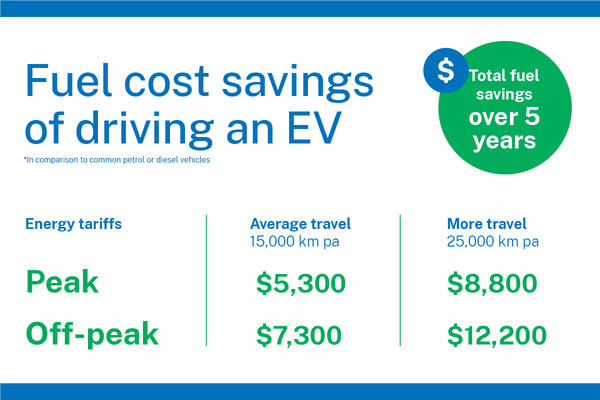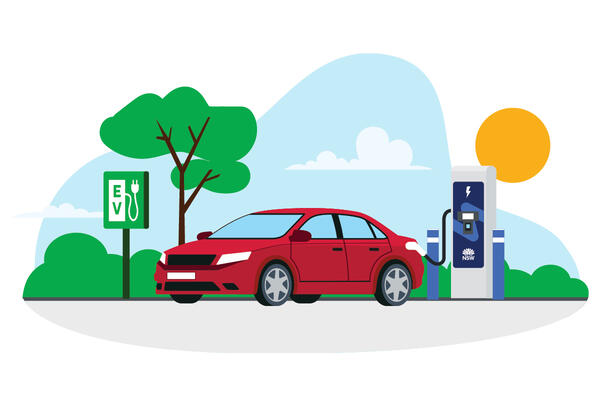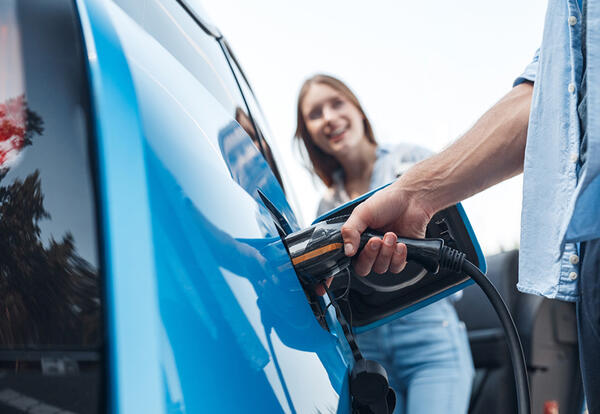
Why buy an electric vehicle?
Owning an electric vehicle has many health, cost and environmental benefits for drivers and the NSW community.
Cost savings
- For an average car travelling 13,700 km per year, this could amount to an annual fuel saving of $1000, or $1200 if the EV is able to charge overnight on an off-peak tariff.
EVs have less moving parts than a petrol or diesel car. There is relatively little servicing and no expensive exhaust systems, starter motors, fuel injection systems, radiators and other parts are not needed in an EV.
Improved driving experience
Electric vehicles are quieter, smoother, and cleaner than the standard petrol and diesel car.
The smoother battery engine removes the noise and heat generated by petrol and diesel engines.
EVs are considered by experts and users as having a greater technical performance than internal combustion engine cars.
EV technical improvements
Faster to accelerate
EVs deliver instant torque so they can accelerate much faster than comparable internal combustion engine cars. With no gears to work through, an EV can apply full power as soon as you touch the accelerator.
Regenerative braking
Most EVs come with some form of regenerative braking system. Lifting your foot off the accelerator – without touching the brake pedal – will slow the car down to a complete stop.
Better handling
Many EVs have been built with the battery running underneath the vehicle, as opposed to the front or rear of the vehicle. This lowers the centre of gravity and provides greater handling.
Quiet and less noise emissions
At low speeds, EVs produce almost no noise, making them more pleasant to drive.
Exceed most people’s daily travel needs
EVs meet most people’s daily travel needs. The average Australian drives around 40km a day. The exact range of an EV will depend on a number of factors including the type of EV, the battery, the type of roads driven and your driving style.
Most EVs can easily travel above 400km, meaning drivers now only need to top up their battery every day or fully charge it once a week.
Improved battery technology will also increase EVs driving range, with new models able to travel 400+ km on a single charge.
Health and environment outcomes
EVs can significantly reduce greenhouse gas (GHG) emissions and harmful tailpipe emissions, especially when paired with renewable energy.
Learn more
In Australia, the transport sector accounts for almost 20% of the total emissions. Transport emissions are the second largest source of emissions (after the energy sector) and the fastest growing source.
Battery electric vehicles have zero tailpipe emissions, reducing the harmful air pollution from exhaust emissions. Pairing an EV with renewable energy, such as solar photovoltaic (PV) and battery storage can further reduce GHG emissions, therefore improving air quality for everyone.
Enhancing Australia’s electrical network
Charging EVs during the night will help achieve a flatter electrical network demand profile over a typical 24-hour period. This will improve the efficiency of the electrical network and encourage better use and optimisation of the whole electricity system.
Electric vehicles can be a controllable load and can maximise renewable energy regeneration, for example delivering renewable energy from middle of day solar gains.
Australian energy security outcomes
Australia is currently highly dependent on foreign fuel supplies. EVs are sourced from local and renewable energy sources thus reducing our reliance on imported fuels.
More information:
Charging an electric vehicle
Find out how to charge an electric vehicle and how long it takes
NSW electric vehicle charging map
Looking to charge your EV? Use the featured map to find your nearest charging station in NSW.
Electric vehicle FAQs and links
Get answers to frequently asked questions about electric vehicles




